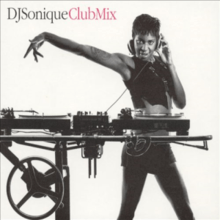
Club Mix
Club Mix is a two-disc album remixed by British musician/DJ Sonique and released in 2001.
Track listing
Disc one
Disc two

Battleforce 2000
Battleforce 2000 is a fictional sub-team from the G.I. Joe: A Real American Hero toyline and comic books. First released in late 1987 (with a final vehicle and member released in 1989), they represent a hi-tech unit of the Joes using experimental weaponry under battlefield conditions.
Toys
The toy line was made up of seven action figures, with the six from 1987 being packaged in both single and two-packs. All but one of the characters was assigned as the primary driver of a hi-tech vehicle, which was sold separately. Dodger was repainted and released as part of the Sonic Fighters line in 1990.
A part of six of the vehicles can be combined to form a small hi-tech fortress called the Future Fortress, which consisted of secondary parts that merely sat next to one another, with no interlocking pieces. Most of the vehicles have a white, silver, grey and dark blue color scheme. An exception is the Pulverizer, the 1989 addition to the series, which does not have a piece that can be combined with the fortress.

MIX (XM)
MIX, often branded on-air as Today's Mix, was a channel on XM Satellite Radio playing the Hot Adult Contemporary format. It was located on XM 12 (previously 22) and plays a mix of hit songs from 1980-present day, except for urban music. MIX was one of 5 channels on XM's platform that plays commercial advertisements, which amount to about 3–4 minutes an hour, and are sold by Premiere Radio Networks. The channel was programmed by Clear Channel Communications, and was Clear Channel's most listened to channel on XM Radio, in both cume and AQH, according to the Fall 2007 Arbitron book.
Artists heard on MIX included Sheryl Crow, John Mayer, Lenny Kravitz, Jewel and Nelly Furtado; and groups like Maroon 5 and Blues Traveler. One can also hear top chart hits including songs from Train, Alanis Morissette, 3 Doors Down, Evanescence, Dave Matthews Band, No Doubt, Santana, Matchbox Twenty, and U2.
On June 8, 2011, this was replaced by a simulcast by WHTZ, licensed to Newark, New Jersey and serving the New York City area.

KMXV
KMXV ("Mix 93.3") is a Top 40 (CHR) station based in Kansas City, Missouri, United States. The Steel City Media outlet operates at 93.3 MHz with an ERP of 100 kW. Its current slogan is "Kansas City's #1 Hit Music Station". It is also one of two Top 40's competing in the Kansas City Metropolitan Area, the other being KCHZ. The station's studios are located at Westport Center in Midtown Kansas City, and the transmitter site is in the city's East Side.
The station was sold off by CBS Radio to Wilks Broadcasting in November 2006 as part of a nationwide reduction of radio stations by CBS. On June 12, 2014, Wilks announced that it is selling its Kansas City cluster (of which KMXV is part of) to Pittsburgh-based Steel City Media. The sale was approved on September 26, 2014, and was consummated on September 30.
History
The station began in 1958 as KCMK-FM (Kansas City, Missouri/Kansas), a classical station, but had several format changes (primarily country) over the next sixteen years. County DJ Jack Wesley "Cactus Jack" Call was at the station (from KCKN) for one week when he was killed on January 25, 1963 in a car crash. Singer Patsy Cline sang at a benefit for him at Memorial Hall (Kansas City, Kansas) on March 3, 1963. She was unable to leave Kansas City the next day because the airport was fogged in and was killed in a plane crash on March 5, 1963 en route from Fairfax Airport to Nashville.
MIX (Microsoft)
MIX is a Microsoft conference held annually for web developers and designers at which Microsoft showcases upcoming web technologies. The conference is held each spring at the Venetian Hotel in Las Vegas. Unlike many of Microsoft's technical conference, MIX has been promoted more heavily to designers by inviting popular speakers from other popular web design conferences, such as SXSW, and has sponsored a CSS design contest each year to promote the conference. Microsoft has also used this conference as an opportunity to promote new web design and development tools such as Silverlight and Microsoft Expression Studio.
On January 24, 2012, the official Microsoft blog stated that there will be no MIX 2012. MIX was replaced by BUILD later that year.
MIX 06
MIX 06 was held from March 20 to March 22, 2006. It focused on the new Internet Explorer 7 and WPF (a part called WPF/E later became known as Silverlight). It featured a keynote by Bill Gates in which he said "We need microformats".

Running (No Doubt song)
"Running" is a song written by Tony Kanal and Gwen Stefani for No Doubt's fifth studio album Rock Steady (2001) and was released worldwide as the album's fourth and final single on July 1, 2003. The song was also used on the last episode of the TV series Sabrina, the Teenage Witch in 2003.
The song received mixed reviews from music critics and was compared to Depeche Mode-style songs. The song only charted on the official charts of the United States, where it became the band's lowest charting single, and in Germany, where it had longest charting period. The song was accompanied by a music video which was directed by Chris Hafner, which featured many old and new pictures as well as clippings of the band members.
Background
The song was written by Stefani and bassist Tony Kanal in Kanal's living room. They used an old Yamaha keyboard that Kanal's father had purchased for him when he was in eighth grade and developed the song's harmony first and then wrote the lyrics. The band worked on the track to give it a "spacier sound" but were displeased with the result so they took the song to producer Nellee Hooper, who stripped Running down to the basics.The song was then produced by him, with whom Stefani collaborated again for her solo project two years later. Whatever the intent, the result was a track that resonated with catchy "Mario Bros." background instrumentation throughout the entire song.

Point of sail
Point of sail is a term used to describe a sailing boat's orientation in relation to the wind direction.
Except when head to wind, a boat will be on either a port tack or a starboard tack. If the wind is coming from anywhere on the port side, the boat is on port tack. Likewise if the wind is coming from the starboard side, the boat is on starboard tack. For purposes of the International Regulations for Preventing Collisions at Sea and the Racing Rules of Sailing, the wind is assumed to be coming from the side opposite that which the mainsail boom is carried, if the vessel is so rigged. The direction of sail is used for square-rigged vessels.
No-go zone
Sailboats cannot sail directly into the environmental wind, nor on a course that is too close to the direction from which the wind is blowing. The range of directions into which a boat cannot sail is called the 'no-go zone'. Its width depends on the design of the boat, its rig, and its sails, as well as on the wind strength and the sea state. Depending on the boat and the conditions, the no-go zone may be from 30 to 50 degrees either side of the wind, a 60 to 100 degree area centered on the wind direction.

